
The politics of Armenia take place in the framework of the parliamentary representative democratic republic of Armenia, whereby the president of Armenia is the head of state and the prime minister of Armenia the head of government, and of a multi-party system. Executive power is exercised by the president and the Government. Legislative power is vested in both the Government and Parliament.
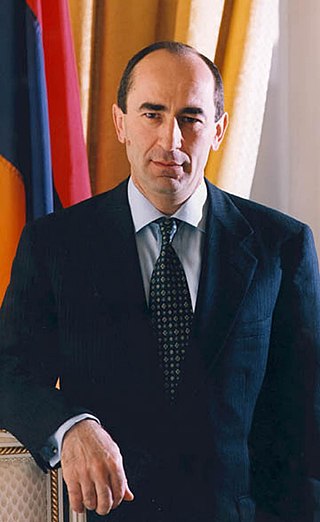
Robert Sedraki Kocharyan is an Armenian politician. He served as the President of the Nagorno-Karabakh Republic from 1994 to 1997 and Prime Minister of Nagorno-Karabakh from 1992 to 1994. He served as the second President of Armenia between 1998 and 2008 and as Prime Minister of Armenia from 1997 to 1998.

The Republican Party of Armenia is a national-conservative political party in Armenia led by the third president of Armenia, Serzh Sargsyan.

Artsakh, officially the Republic of Artsakh or the Republic of Nagorno-Karabakh, was a breakaway state in the South Caucasus whose territory was internationally recognised as part of Azerbaijan. Between 1991 and 2023, Artsakh controlled parts of the former Nagorno-Karabakh Autonomous Oblast of the Azerbaijani Soviet Socialist Republic, including its capital Stepanakert. It had been an enclave within Azerbaijan from the 2020 Nagorno-Karabakh war until the 2023 Azerbaijani offensive, when the Azerbaijani military took control over the remaining territory controlled by Artsakh. Its only overland access route to Armenia after the 2020 war was via the 5 km (3.1 mi) wide Lachin corridor, which was placed under the supervision of Russian peacekeeping forces.

Armenia has a multi-party system. After the 2015 Armenian constitutional referendum, only a legislature is elected on the national level.

Artsakh elected on a national level a president and a parliament. The president was elected for a five-year term by the people. The National Assembly had 33 members, 16 elected for a five-year term in single-seat constituencies and 17 by proportional representation.

Politics of Artsakh took place within the constraints of a written constitution, approved by a popular vote, that recognises three branches of government: executive, legislative and judicial. The executive branch of government was exercised within a framework of a presidential representative democratic republic, whereby the President of Artsakh was both the head of state and the head of government. The legislative branch of government was composed of both the Government and the National Assembly. Elections to the National Assembly were on the basis of a multi-party system. The republic was de facto independent and de jure a part of Azerbaijan. None of the elections in Artsakh were recognised by international bodies such as the OSCE Minsk Group, the European Union or the Organisation of Islamic Cooperation. Both Azerbaijan and Turkey had condemned the elections and called them a source of increased tensions.

The National Assembly of the Republic of Artsakh was the legislative branch of the government of the former Republic of Artsakh.

Arayik Vladimiri Harutyunyan is an Armenian politician who served as the fourth president of the Republic of Artsakh from May 2020 to September 2023. Under his predecessor Bako Sahakyan, he served as the sixth and last Prime Minister from 2007 until the abolishment of that position in 2017 and as the first State Minister of the Republic of Artsakh from 2017 until his resignation in 2018. Harutyunyan led Artsakh through the 2020 Nagorno-Karabakh War with Azerbaijan, during which the republic lost most of the territory under its control. He resigned on 1 September 2023 in the midst of the Azerbaijani blockade of Nagorno-Karabakh.
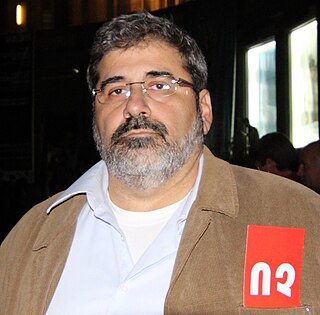
Giro (Kiro) Manoyan is an Armenian politician, one of the leaders of ARF Dashnaktsutiun and the head of its Armenian Cause Office.

Parliamentary elections were held in the Nagorno-Karabakh Republic on 23 May 2010.

The Constitution of the Republic of Artsakh was the basic law of the Republic of Artsakh. It was approved by the people of Artsakh in a referendum that was held on 20 February 2017. It superseded the constitution previously ratified by the people in 2006. Over 76.5% of the electorate participated in the 2017 referendum. Of these, over 90% voted for its adoption with just under 10% voting against its adoption. This constitution proclaimed the Nagorno-Karabakh Republic to be a sovereign, democratic state that was based on social justice and the rule of law. The constitution stated that the names "Republic of Artsakh" and "Republic of Nagorno-Karabakh" were synonymous. The constitution affirmed that all power is vested in its citizens, who exercise it directly through constitutional referendums and indirectly through their elected representatives. Proposed changes to the constitution or to an alteration of the borders of the State had to be ratified by the people in a referendum. Stepanakert was defined as the state's capital. As a result of the Azerbaijani offensive, the constitution was repealed when on 28 September 2023, the president of Artsakh subsequently signed a decree to dissolve all of the republic's institutions by 1 January 2024, under article 93, bringing its existence to an end.

Hayazn is an Armenian nationalist political party, that was founded as a civil organization in 2009. It declared itself a political party in 2013 and was registered as such in 2014.

The political status of the Republic of Artsakh remained unresolved from its declaration of independence from the Soviet Union on 10 December 1991, to its September 2023 collapse. During Soviet times, it had been an ethnic Armenian autonomous oblast of the Azerbaijan Soviet Socialist Republic. Following the dissolution of the Soviet Union, a conflict arose between local Armenians who sought to have Nagorno-Karabakh join Armenia and local Azerbaijanis who opposed this.

The Karabakh movement, also known as the Artsakh movement, was a national mass movement in Armenia and Nagorno-Karabakh from 1988 to 1991 that advocated for the transfer of the mainly Armenian-populated Nagorno-Karabakh Autonomous Oblast of neighboring Azerbaijan to the jurisdiction of Armenia.
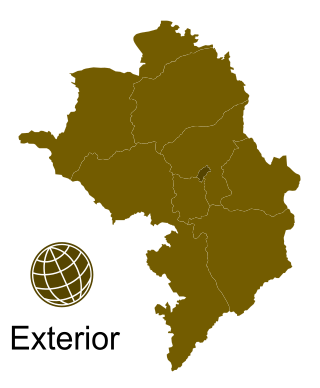
General elections were held in the Republic of Artsakh on 31 March 2020, with a second round of the presidential election on 14 April. Voters elected the President and 33 members of the National Assembly. It was the first time the President and National Assembly were elected at the same time.
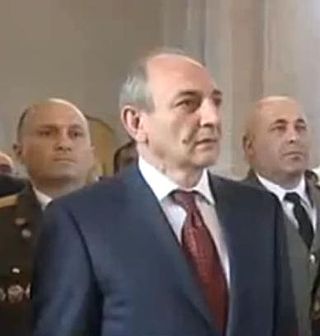
Indirect presidential elections were held in the unrecognised Republic of Artsakh on 19 July 2017. The incumbent, Bako Sahakyan, was elected to a third term.
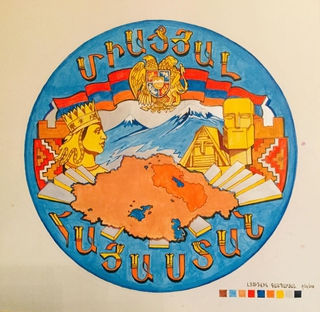
The United Armenia Party is an Armenian political party in Artsakh.
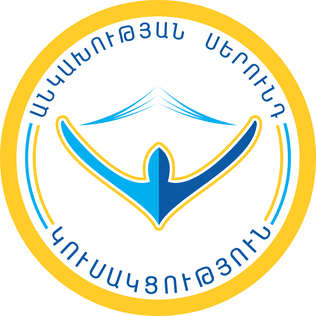
The Generation of Independence Party is an Armenian political party in Artsakh.
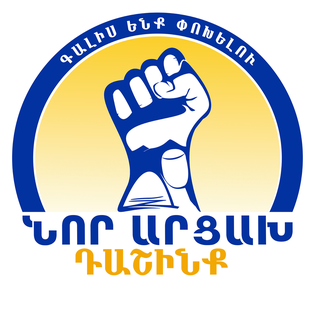
The New Artsakh Alliance is an Armenian political alliance in Artsakh.















